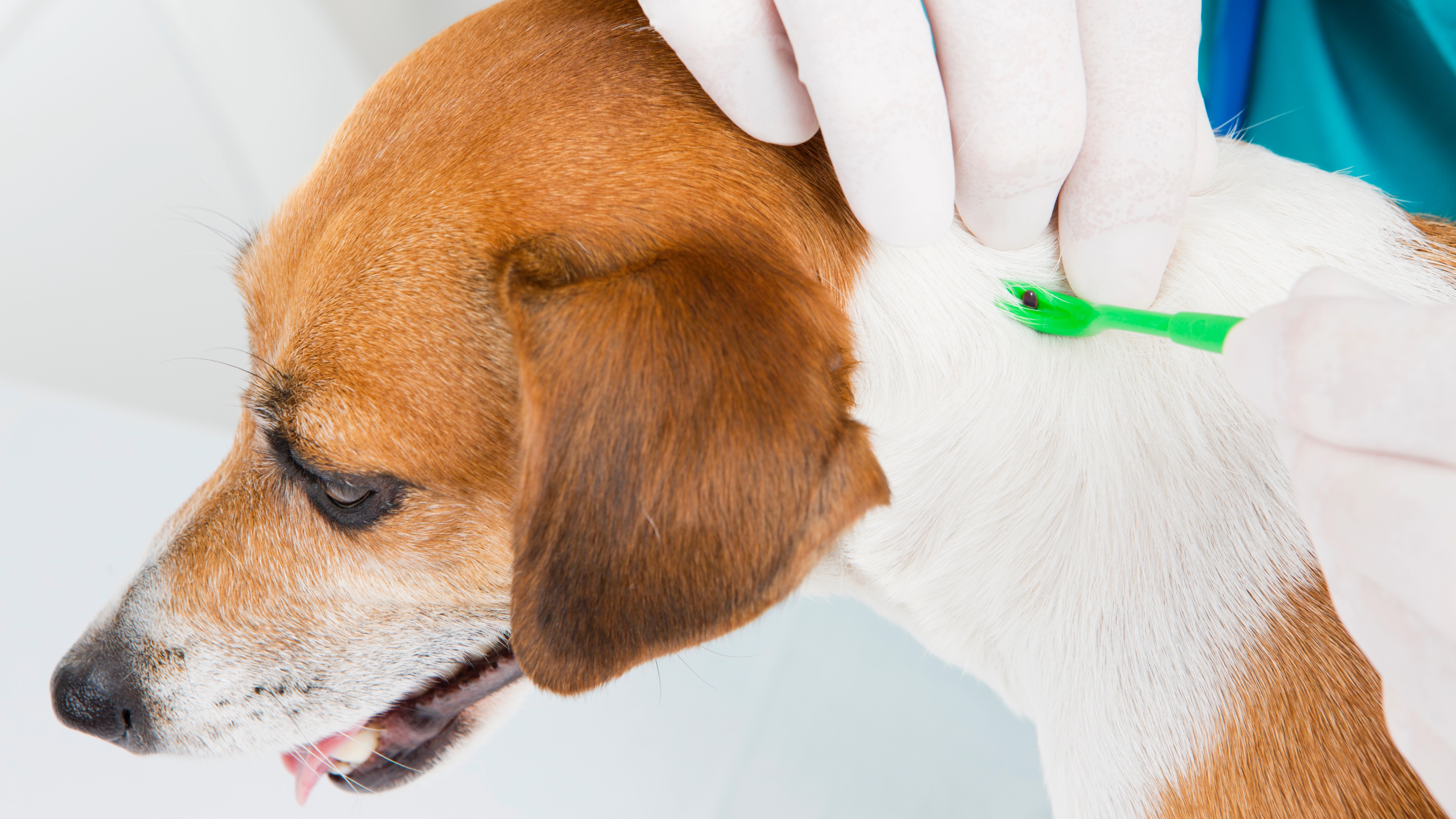How to remove a tick from your pet (a step-by-step guide from a vet)
Here's how to remove a tick from your pet safely — and it's easier than you might think.

Trying to figure out how to remove a tick from your pet? We understand that it can feel like a daunting situation to be in, so we turned to expert vet Dr. Elizabeth Racine to help walk us through the process.
Ticks are common parasites and are found all over the world. Not only does their bite have the potential to cause disease, they can also transfer themselves onto humans, posing a risk to your own health and wellbeing.
It’s important to treat your pet regularly with the best flea treatment for dogs or the best flea treatments for cats and to choose a product that also offers tick protection. This will ensure that parasites don’t hitch a ride on your pet.
If you’ve found a tick on your fur friend or you’re simply curious about what to do should this ever happen, you’ll find everything you need to know in this guide. Below, Dr. Racine walks you through how to remove a tick, what to do after you’ve removed it, and how you can prevent ticks from taking up residence in your dog or cat's coat.
Common diseases in pets caused by ticks
Ticks aren’t just bloodsuckers – they can also transmit diseases to your pet. When ticks bite, they attach themselves firmly and can stay attached for several days. During that time, bacteria in the tick’s saliva can be passed to your pet. Some tick-borne illnesses can be transmitted within a few hours of a bite, so it’s important to remove an embedded tick as quickly as possible.
Some of the more prevalent tick-borne diseases in dogs include Lyme disease (which is one of the most common illnesses dogs get) , Canine Bartonellosis, Rocky Mountain Spotted Fever, and Canine Anaplasmosis. Some of the most common illnesses in cats caused by ticks include Lyme disease, Tularemia, Cytauxzoonosis and Anaplasmosis.
However, it's worth bearing in mind that not every tick will cause illness. The prevalence of ticks and the diseases they can transmit varies with geographic region. Regardless of where you’re located, it’s important to remove the tick from your pet as soon as you find one as illnesses such as Lyme disease in dogs and cats have poorer outcomes the longer they go untreated.
Get the best advice, tips and top tech for your beloved Pets
How to remove a tick from your pet
If you've been asking questions like 'why is my dog itching, scratching and biting himself constantly?' or why is my cat overgrooming?, the first thing you want to do is examine them for fleas and ticks.
When you find a tick on your pet, you should get it off right away. Removing a tick as soon as possible will help reduce the risk of it transmitting diseases to your pet. If the tick is crawling on your pet, you can easily brush it away or pull it off with a tissue. But if the tick has bitten your pet, its head will be embedded under your pet’s skin, and you’ll need to remove it more carefully.
Follow these steps to remove a tick safely:
1. Part your pet’s fur so you can see the tick clearly.
2. Using tweezers or a tick-removal tool, grasp the tick as close to your pet’s skin as possible. Do not try to grab the tick by the body or legs, because this may crush the tick and cause it to break apart.
3. Holding the tick’s head firmly, slowly pull straight back away from your pet’s skin. You may feel a slight “pop” as the tick is removed.
4. Check the area to ensure you’ve removed all of the tick.
5. Perform a ‘tick check’ to look for any other ticks on your pet. Most are found on the head, neck, chest, and legs.
After removing a tick from your pet, you may notice some mild redness or swelling in the area of the tick bite. This is normal and should resolve within a few days. If the swelling doesn’t improve or if you notice other symptoms such as pain, lethargy, or fever, your pet should see a veterinarian right away.
TickCheck Tick Remover Kit
$12.95 from Amazon
This kit features a stainless steel tick remover for larger ticks and a pair of tweezers to remove smaller ticks. University-tested, it's been proven to be highly effective at removing embedded ticks from dogs and cats.
What to do after removing a tick

In most cases, it isn’t necessary to save the tick or bring it to your veterinarian. Testing the tick itself for illness isn’t always useful, because there’s no way to know whether the tick actually transmitted the disease it was carrying. Your veterinarian will likely recommend monitoring your pet for common symptoms of tick-borne illnesses, such as lameness, lethargy, fever, and loss of appetite. If you notice any of these signs, see your veterinarian right away for further care.
In some cases, your vet may recommend testing your pet for certain tick-borne diseases that are common in your area. This type of testing is typically performed a few weeks after the initial tick bite. If your pet tests positive for exposure to one or more of these diseases, your veterinarian will determine the best course of treatment. Most cases of tick-borne disease are treatable and have a good outcome as long as they are identified early.
How to prevent ticks on your pet
The quickest and easiest way to protect your pet from ticks is to use a prescription preventive medication recommended by your veterinarian. These medications come in both topical and oral forms, so it is easy to find a product that works well for your pet. In many regions, it is recommended that your pet continues to take these preventive medications year-round.
You can also protect your pets by avoiding areas where ticks are most common. Long grass, low brush, and forested areas are natural habitats for ticks. Keep your pet away from these areas as much as possible, especially during the warmer months.
After spending time outdoors, be sure to check your pet thoroughly and remove any ticks you find. This is especially important in breeds with thick coats, where it’s easy for ticks to hide. Don’t forget to check cracks and crevices, such as inside the ears, between the toes, and under the tail, where ticks can easily be missed.
Tick-borne illnesses can be serious, but there are steps you can take to protect your pet from these common parasites. Keeping your pet up to date on preventive medications and removing ticks as soon as you find them will help keep your pet safe this summer. For further guidance on ticks and your pet, consult your veterinarian about the common ticks in your area.
Looking for more great vet-led content? Check out this guide to why is my flea treatment not working for expert advice on how to use these treatments effectively.
Dr. Elizabeth Racine is a small animal general practice vet covering all things pet health and wellness. Her special interests include veterinary behavior, nutrition, and internal medicine.
As a freelance writer, Dr. Racine has written content for major companies in the industry such as the American Kennel Club, Merck Animal Health, Bayer PetBasics, Elanco, and CareCredit. In her free time, Dr. Racine enjoys playing trampoline dodgeball, hiking with her beagle Dasher, and spending time with her three mischievous cats.


